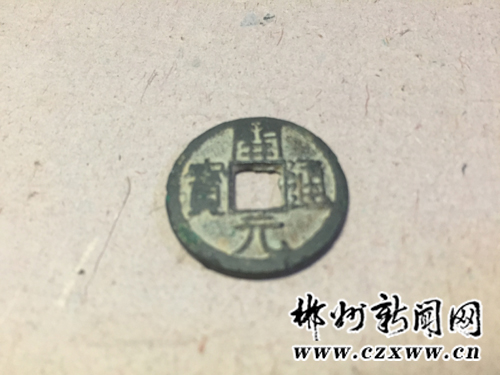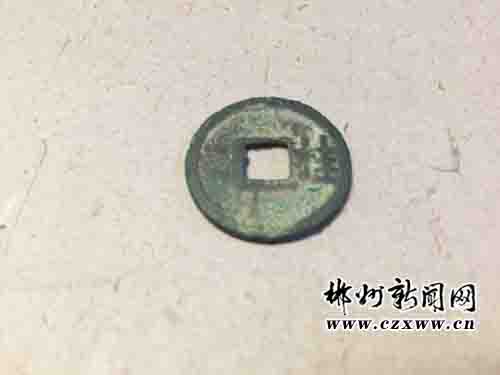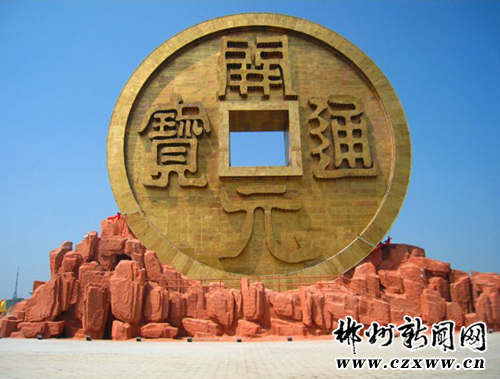Secret Lying on Copper Cash Marked Chinese Character“桂”(Gui)

An amateur of antiques collection- Ouyang Renkai showed his collection of “Kaiyuantongbao” coin to the reporters.

There is a Chinese character “桂”(Gui)
Recently, an amateur of antiques collection- Ouyang Renkai showed his collection of “Kaiyuantongbao” coin which was marked with a Chinese character “桂”(Gui)to the reporters and introduced its historical culture stories as well.
Ouyang Renkai who was a staff of town government of Datang village of Beihu district found some coins in his Grandma’s in Grade 3 in primary school. He started the collection since then. Beside coins, silver dollar, some other antiques as operation command maps on Anti-Japanese War and war of liberation, and etc. were collected by him.
The coin which was marked with a Chinese character “桂”(Gui)was one of collections of Ouyang. Four characters of “开元通宝” ( Kaiyuantongbao) were marked in the front of the coin, while one character of “桂”(Gui)- the name of origin place Guiyang was marked in the back. From Tang Dynasty, Guiyang was in charge of manufacturing the coins. There were 99 foundry furnaces of the country during that period, 5 of which were set in Guiyang county with the production capacity of 50,000 strings of coins. The coin which was marked with a Chinese character “桂”(Gui) was one of the types of “Huichangkaiyuan”originated from Huichang period of Tang Dynasty. In the early age of Tang Dynasty, Guilin of Guangxi province casted the coin of “Kaiyuantongbao”, but no mark of the originate marked on the back of the coin. The 20th year of Emperor Dezong of Tang Dynasty (804 A.D.), the coin production work was started in Guiyang county. The character “桂”(Gui) was started to be marked on the back of the coin from Huichang period of Emperor Wuzong of Tang Dynasty. In the following hundred years, a large amount of coins with different levels of quality were produced there. Generally speaking, the quality was changed on the basis of the power of Tang Dynasty, so the coins produced in early age of Tang Dynasty was elegant while the ones produced in late Tang Dynasty was poorer.

The character of “元”(Yuan) marked in the coin of“Kaiyuantongbao” is with left hook, so it was called as “left hook Yuan”
What is the specialty of this coin of“Kaiyuantongbao”? As introduced by Ouyang Renkai that the character of “元”(Yuan) marked in this coin is without hook, so it was called as “straight Yuan”. Generally speaking, the coins of “Kaiyuantongbao” manufactured at that period were marked with left hook or right hook (please refer to following images accordingly). The largest copper coin set on the top of Guiyang Baoshan is a coin of “left hook Yuan”. What would be the key reasons for manufacturing different versions of the character of Yuan? As guessed by Ouyang Renkai, it would be caused by the furnaces and times of production. Some models would be changed for a time, and the model of this “straight Yuan” was rare.

Lead “Kaiyuantongbao” marked with “桂”(Gui)of M-Chu Kingdom discovered in Jinmandi of Changsha city
As introduced by Ouyang Renkai, some lead “Kaiyuantongbao” marked with “桂”(Gui)of M-Chu Kingdom were discovered in Jinmandi of Changsha city in 1980s’-1990s’. Though the coins marked the same characters on both front and back side as the coins manufactured in Guiyang county, they were actually manufactured in Tanzhou furnace (Changsha). It indicated that the coins manufactured in Guiyang county were widely circulated in Hunan province in that period with significant influence, so the government of the Five Dynasties still followed the model to make coin of “Kaiyuantongbao” and marked with “桂”(Gui). Thousands of years later, it is seldom to see such coins.
It was learned that Ouyang Renkai once had 16pcs of this coin, 13 of which were transferred to some other collectors, one was saved by himself, and the rest two were exhibited on exhibition hall of Guiyang Archives Bureau.





